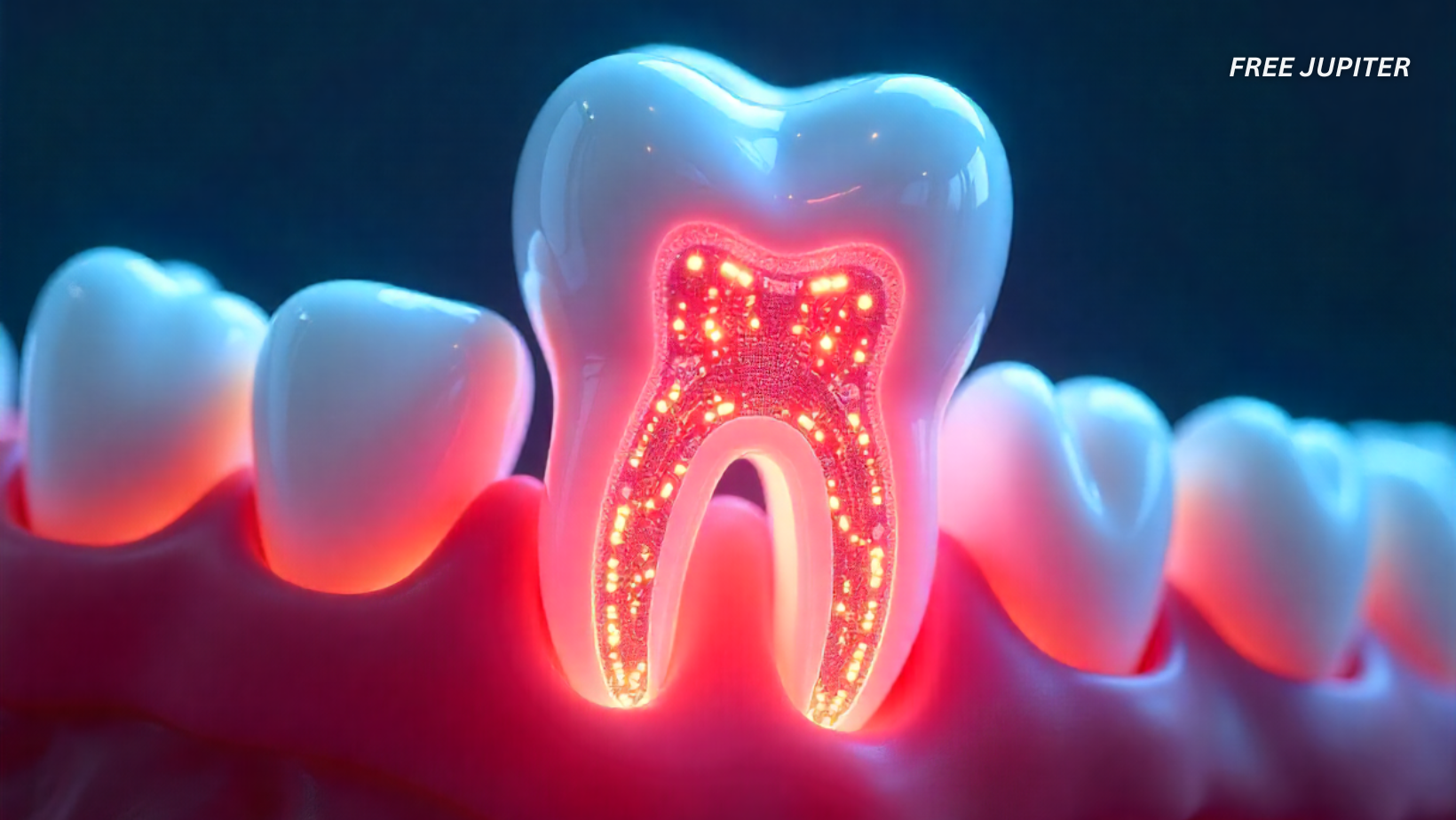Friendly Note: FreeJupiter.com shares general info for curious minds 🌟 Please fact-check all claims—and always check health matters with a professional 💙
What if getting a dental implant didn’t just fix your smile—but also reconnected your tooth to your brain? Sounds like something out of a sci-fi novel, right? Well, scientists at Tufts University are turning that idea into a real-world innovation.
Say hello to the “smart tooth”—an experimental new implant that doesn’t just fill a gap in your gumline. It grows into your tissues, connects to your nerves, and—get this—restores the feeling that most people lose after tooth extraction.
Let’s dig in (gently, like flossing) and explore how this quirky piece of science could completely change how we think about dental implants—and maybe even more than that.
Traditional Implants: Tough, Silent, and Sensationless
Conventional dental implants are basically titanium placeholders. They’re strong, dependable, and shaped like screws that anchor into the jawbone. Dentists cap them off with crowns that look just like natural teeth. And while they work wonders for chewing, biting, and cosmetic appearance, there’s one major drawback—they’re completely numb.
Why? Because when you lose a natural tooth, you also lose the intricate web of tiny nerves that once ran through it. Traditional implants don’t reconnect with these nerves. They don’t “feel” anything. There’s no communication between your mouth and brain, which means subtle sensations—like the pressure of biting or the warning sting of hot coffee—are gone.
This lack of sensory feedback can mess with more than just eating. It can impact speech, facial muscle coordination, and even trigger changes in chewing patterns over time. In short, you’ve got a tooth that looks the part but doesn’t quite play the part.
Read more: No More Fillings? Scientists Successfully Grow Human Teeth in the Lab
Enter the Smart Tooth: A Living, Breathing Upgrade
The smart tooth developed by Tufts researchers flips this story upside down. Instead of being a passive, artificial placeholder, it acts more like a biological collaborator.
At the heart of this invention is a clever twist: the implant is wrapped in a biodegradable scaffold—a kind of soft, temporary casing. But this isn’t just packaging. It’s loaded with stem cells and a special protein that promotes nerve regeneration.
The idea is pretty elegant: once the implant is placed into the empty tooth socket, the outer layer slowly dissolves while the stem cells and proteins do their thing. The body starts to heal around it, encouraging gum and nerve tissue to regrow and eventually link up with the implant.
That means instead of just plugging a hole, the smart tooth becomes part of the gum, fusing into the natural architecture of the mouth. Over time, it could allow the brain to receive signals from the implant—just like it used to with the original tooth.
Yes, you read that right: a fake tooth that talks to your brain.
No Drills, No Screws, No Problem?
One of the most fascinating features of this new implant is that it may not even require the traditional screw-and-drill method to stay in place. Thanks to its soft tissue integration, it may secure itself naturally as it fuses with the surrounding gum tissue.
That’s not just more comfortable for the patient—it could also reduce complications, recovery time, and the need for bone grafting, which is often required when someone’s jawbone isn’t thick enough to hold a metal implant.
Think of it as dental work with a softer, more biological touch. Instead of brute force and titanium, you’ve got stem cells, proteins, and a carefully engineered scaffold that invites the body to help finish the job.
Read more: Humans Are Still Evolving—And Our Teeth Might Be Disappearing: New Study
So… Does It Actually Work?
This all sounds dreamy, but what’s the real-world evidence?
So far, the smart tooth has been tested in rodents—and the results are promising. Within six weeks of implantation, scientists observed clear signs that the rodents’ nerve tissue was beginning to grow into the implant structure. Even more importantly, the implant didn’t trigger immune rejection or cause inflammation—key signs that the body was accepting it as part of the team.
While these rodent trials are just the first step, they’re a crucial one. The fact that the implant was both biocompatible and showed signs of nerve connectivity makes it a standout among next-generation dental materials.
The researchers now plan to study brain activity in these rodents to confirm that the new tooth is indeed sending sensory signals to the brain. If that’s confirmed, it would be one of the first major breakthroughs in restoring full tooth function—including sensation—through an implant.
What’s Next? Scaling Up to Larger Mouths (and Eventually Ours)
The next phases of this research will involve larger animals, whose mouths and nerve systems more closely resemble humans. Eventually, the researchers hope to reach clinical trials with actual people.
If successful, this could change the standard of care for dental replacements. Instead of patients settling for a tough but unfeeling implant, they might receive a replacement that can regrow tissue, respond to sensations, and possibly last longer due to its integration with living cells.
But the implications don’t stop at the dentist’s chair.
Beyond Teeth: A Glimpse into the Future of “Living” Implants
This nerve-friendly technology could open doors in other fields of medicine—especially in orthopedics and neuroprosthetics. Think about joint replacements or artificial limbs that could, one day, connect to the nervous system, enabling patients to feel pressure, temperature, or even pain (useful as a warning system, not as punishment).
A knee implant that senses strain? A prosthetic hand that detects texture? A spinal disc replacement that talks to the brain? These aren’t wild dreams anymore. The humble beginnings of such possibilities may start with a single smart tooth.
This work reflects a bigger trend in science: the push to make synthetic body parts more biologically intelligent. Not just substitutes, but collaborators—working with the body rather than just sitting in it.
The Tiny Tooth That Could
It’s easy to overlook teeth. They’re just there, doing their job—until they aren’t. And when one is lost, the effects ripple beyond the empty space.
The invention of a smart, sensation-friendly implant could restore more than just chewing power. It could restore the subtle feedback loops we rarely think about but deeply rely on—especially for speech, expression, and everyday interactions with food and the world around us.
We’re still a few steps away from these smart teeth showing up in your local dental clinic, but the progress is real—and surprisingly fast.
From metal screws to self-growing, nerve-talking implants, the world of dentistry may be on the cusp of its most significant transformation in decades. And if the technology succeeds, the phrase “fake tooth” might one day feel outdated—because these new teeth are aiming to be just as real, functional, and responsive as the ones we were born with.
Read more: What Are ‘Ozempic Teeth’? The Latest Unusual Side Effect of the Weight-Loss Drug
Final Thoughts: What This Means for Everyday People
Let’s bring it back down to Earth. If you’ve ever had a dental implant—or know someone who has—you’re aware that it’s a serious procedure. It’s expensive, time-consuming, and while the results can look great, they never quite feel natural. You learn to adjust.
But with the development of this smart tooth, we may be entering a future where you don’t have to adjust—because the replacement tooth adjusts to you.
It heals with your gums. It reconnects to your nerves. It feels pressure and sensation. It may even prevent some of the long-term side effects of traditional implants, like bone loss or jaw changes.
All this from a single, tiny upgrade made possible by a biodegradable wrapper, a few stem cells, and a lot of clever science.
Sometimes, big revolutions come in small packages. And this one? It fits right in your mouth.
Disclaimer: The information in this article is for general informational purposes only and is not medical advice. We are not doctors, and this website is run as a family hobby project. Always consult a qualified healthcare professional before making decisions about your health. Please fact-check any claims and use this content as a starting point, not a substitute for professional guidance.










